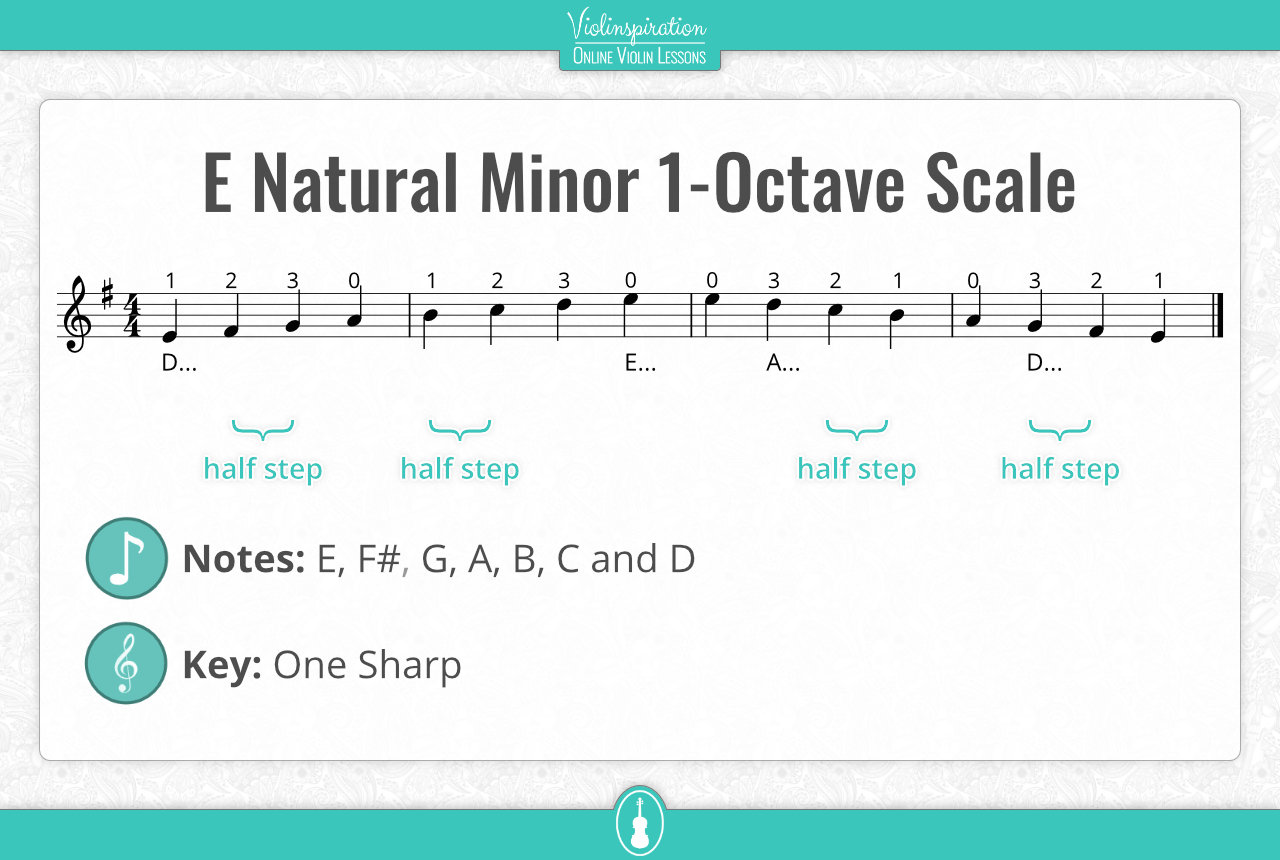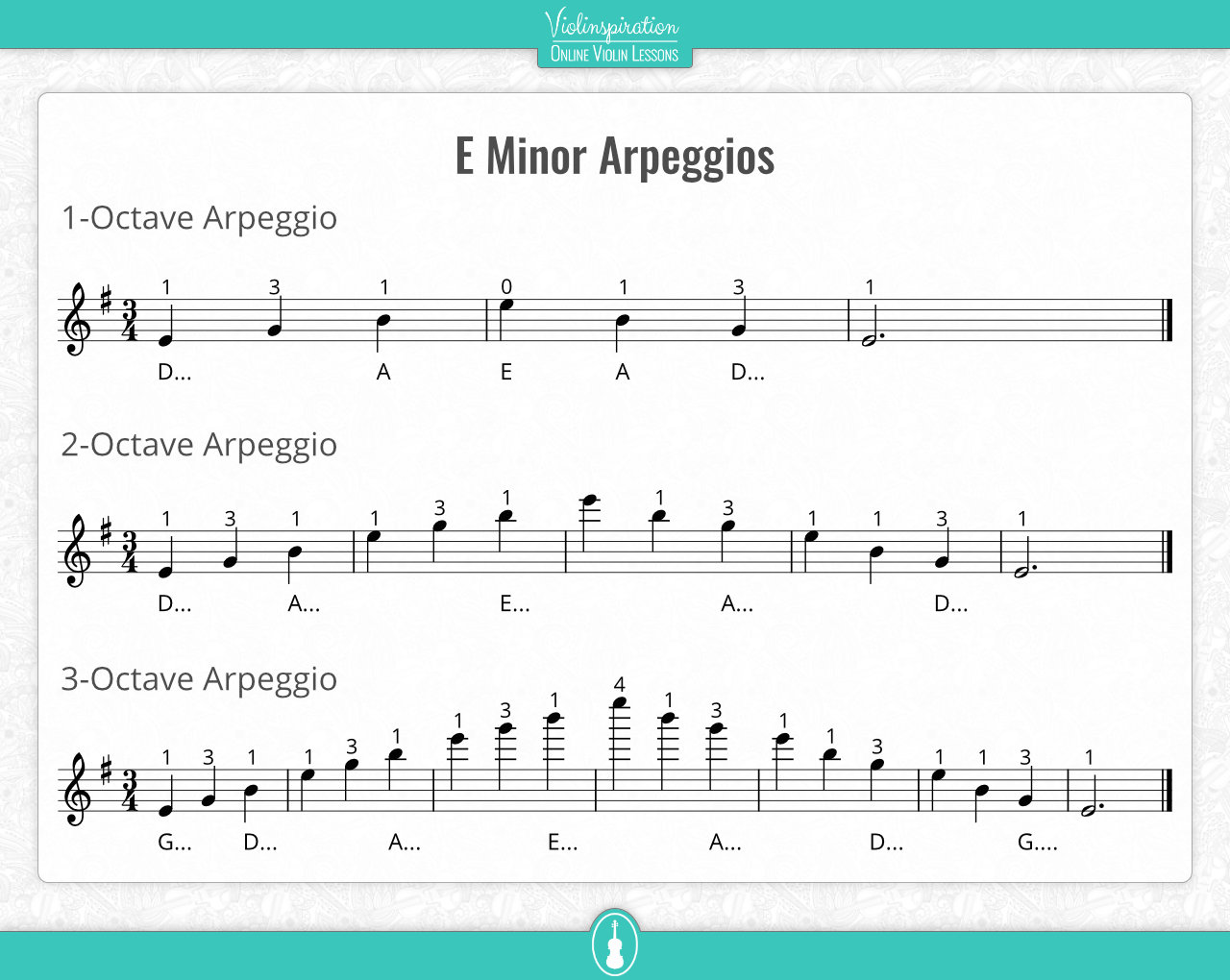
E minor scale on the violin is easy to learn and a great place to start if you want to play pieces in a minor key.
You may encounter three versions of any minor scale: the natural, harmonic, and melodic. But today, I am focusing on the E natural minor scale.

E Minor Scales, Arpeggios
and a Bonus Exercise
What Notes Are in the E Minor Scale?
The notes of the E minor scale are E, F#, G, A, B, C, and D.

How Do You Play the E Minor Scale on the Violin?

The left-hand position for playing the E natural minor scale is the same as its relative major scale, G Major because it has the same key signature containing one sharp, F#.
What is important to remember about playing this scale is that on the D string, you use a high second finger when you play the F# and a low second finger on the A string when you play the C, so it is good to pay attention to that when you practice.
How do you play an E Minor Arpeggio on the Violin?
An arpeggio is when you play the notes of a chord in succession, using the scale’s first, third, and fifth notes to build the chord. In E-minor, you’ll play E, G, and B in succession.

How do You play a Two-Octave E Natural Minor Scale on a Violin?
Playing a two-octave E natural minor scale requires a bit of shifting. You shift into the third position on the A string to finish the first octave.
On the E string, there’s a shift to fourth position to finish playing the scale upwards.

Three-Octave E Natural Minor Scale on the Violin
The three-octave E minor scale starts in fifth position on the G string and shifts into the seventh playing position on the A string. You have a few more shifts on the E string to the higher playing positions to complete the scale.

Sheet Music of the E Natural Minor Scale & Arpeggio
Remembering how to play these scales by simply reading about them is challenging. It helps to practice them on your violin so you know where the notes are and can play them in tune.
To make this easy, I made sheet music you can download below with all the notes and fingerings for the E minor scales and arpeggios I mentioned above.

E Minor Scales, Arpeggios
and a Bonus Exercise
How to Practice the E Minor Scale
Many of my students find playing scales boring compared to working on repertoire. However, in order to play your repertoire well and in tune, you need to practice them.
A great way to do this is to play them with variety. Some examples are:
- Vary your bowing: play smooth longbows, then detache, martele, and some staccato bow strokes.
- Vary your slurs: try playing two-note slurs, then four-note slurs, and eight.
- Vary your rhythm patterns: playing scales with different rhythm patterns will not only help you with intonation, but it is also fun!
- Vary where you bow: try playing the scale only at the frog or the tip. Practicing this way will help to smooth out your bow changes when playing.
5 Well-known Pieces in the Key of E Minor
Here are five of my favorite pieces composed in this key. I hope you enjoy listening to them and learning about their composers.
Harry Potter Theme Song – Hedwig’s Theme by John Williams
John Williams composed music for only the first three Harry Potter movies, but Hedwig’s Theme can be heard in all eight movies. If you like this theme song, then make sure to check out my tutorial and play along in the Video Library over here!
Violin Concerto in E minor by Mendelssohn
Felix Mendelssohn may be best known for his Wedding March from A Midsummer Night’s Dream and the melody for the Christmas carol, Hark the Harold Angels Sing, but equally appreciable is his Violin Concerto.
Two things make it stand out. First is the structure of the composition. Mendelssohn creates musical continuity by linking the final chord of one movement, without pause, to the first note of the next.
Second is the violin solo (cadenza). Traditionally, a composer will place the cadenza at the end of a movement. Mendelssohn, however, artistically places it two-thirds through the first at the climactic turning point.
Symphony No. 9 in E Minor by Dvořák, also known as “From the New World”
African-American spirituals and Native-American music inspired the Czech composer’s Symphony No. 9, which he wrote during his short time in America. It premiered at Carnegie Hall on December 13, 1893, with a performance by the New York Philharmonic.
Symphony No. 4 in E minor by Johannes Brahms
Symphony No. 4, Op. 98 is the last of Brahms’s symphonies. The premier was in Germany on October 25, 1885.
Having developed cancer, Brahms made his last public appearance on March 3, 1897, at the performance of his Symphony No. 4 with Hans Richter conducting and aged 63 died one month later, on April 3, 1897.
Symphony No. 44 “Trauer” by Joseph Haydn
Joseph Haydn is known as the father of the symphony, not because he developed the form, but because he composed so many: 106, to be exact.
Symphony No. 44, commonly known as Trauer or “Mourning” in English, exemplifies Haydn’s strum and drang (storm and stress) phase at his best. Legend has it that he wished the slower movement, Adagio, to be played at his funeral.

You may also like…
- Learn more violin scales – major and minor
- Check out my music theory posts over here
- Or, relax and read some violin-related fun facts!























